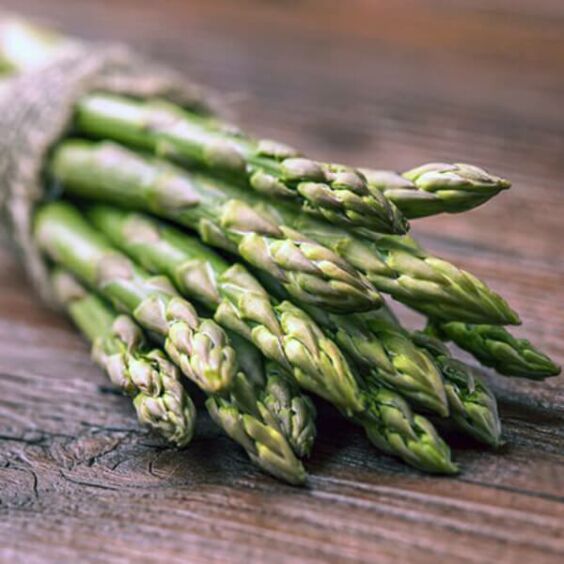
Growing zones
See Zone Map >Status: Out of stock
- Sun
Mature Plant Size (H x W): 3-4' x 1-2'
- Edible to People
Planting & Care for Edible Plants - Mary Washington Asparagus
Preparation
- Mary Washington Asparagus needs plenty of room to grow.
- Pick a sunny location to plant.
- Make sure your soil pH level is around 6.5-7.0. If you’re not sure contact your local UW Extension office to help test your soil level.
- Asparagus is planted in early spring as soon as the soil can be worked.
- Asparagus does not like to have its feet “wet,” so be sure your bed has good drainage. For that reason, raised beds can be a good place to plant asparagus.
Opening Plant Material
- Bare Root - Cut open the bundle (top and roots are tied) and separate all the plants. Soak roots in buckets of water until planted (preferably overnight). Each plant type will be labeled separately for identification. Do not expose the roots to sun. They should never dry out. Keep roots covered. All bare-root plants must be trimmed when planted.
Planting Bare Root
- Prepare a bed of fine, loamy soil to which a liberal dressing of composted manure has been added and tilled in.
- Plant 1 foot apart in rows 4 feet apart.
- To plant, make a trench about 6" to 8" deep.
- Plant Asparagus with the bud facing upward and cover with 3" of soil. Water well.
- As plants start to grow, fill in trench with the additional soil until, by mid-summer, the ground is level.
- When the trench is filled, add a 4 to 8 inch layer of mulch and water regularly.
- Do not cut any new shoots, but allow the "ferny" foliage to grow and store food for next year.
- Scroll below and click on the orange box “Handling & Planting Guidelines” for an illustration on how to plant these bare root plants.
Pruning – After Planting
- Do not cut any new shoots, but allow the ""ferny"" foliage to grow and store food for next year.
Pruning - Through-out the Season
- Cut down dead foliage in late fall and side-dress with compost.
Harvesting
- Do not harvest the spears in the first year, but cut down dead foliage in late fall and side-dress with compost.
- >Asparagus can take three growing seasons to harvest; you may be able to lightly harvest during the second year.
Watering - After Planting
- Plants typically take approximately 6 weeks to establish new roots in your soil. During this period, water plants as often as every 2-4 days at the start and at least a minimum of once per week. Beyond the 6 week establishment period, water once per week, unless rains occur.
- Stick your finger into the soil around 3” to check soil moisture.
Watering - Through-out the Season
- After the first season, plants should only be watered during extended periods without rain.
- How do you know if your plants need water? The easiest way to tell is to touch the soil around the roots. If it is moist, there is no need to water. If it is dry, give it a good soaking with the hose end (no nozzle) watering the soil only, not the leaves
- Stick your finger into the soil around 3” to check soil moisture.
Planting & Handling Help
Download our Planting and Handling Guide below to plan for a successful arrival and install of your plants. Be sure to water all plants as soon as they arrive and every day until you’re ready to plant. Keep any bare root bundles in a shady, cool spot with the roots covered at all times.


Learn More
Watch our videos on handling bare root plants, how your order is prepared for shipment and more.


Plant Sizing
What is the difference between Containers, Grow Bags, Bare Root, and Balled & Burlap (B&B)?
Shipping Times


Our FedEx and local shipping times depend on two factors, one is by the region and the second is the type of product being shipped. For example, small fruits are only shipped in spring, but majority of our perennials are shipped from spring until fall. Keep in mind the dates below act as a general guide. Due to unpredictable weather, staffing, inventory and industry demands these timelines can change. Therefore, we cannot guarantee any of these times.
Shipping Dates by Region*
Northern Cold Region: April 22nd - November 7th
Northern Region: April 15th - November 7th
Middle Region: April 1st - November 7th
Southern Region: March 15th - November 7th
Local Delivery (small radius from Waterloo, WI): April 22nd - November 7th
Shipping Dates by Season*
Spring Shipping: Region Start Date (above) - May
Fall Shipping: September - November
Due to unpredictable weather, these times may vary. Some varieties are exceptions due to heat and plant health reasons. Enter your shipping zip code at the top of this page and be sure to check the shipping information on each product before you add it to your cart. If the product is too large or restricted in your state, you will not be able to checkout with that item in your cart.
